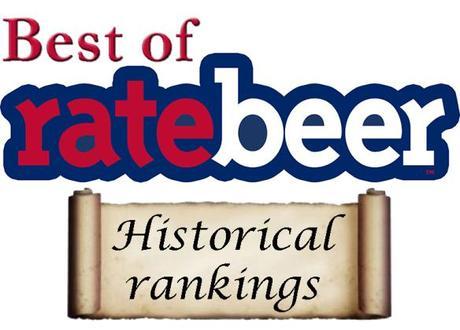
After looking back at RateBeer user preferences for 2014 as all as a comparison of the last two years, it's time to take a step even further back.
RateBeer's "best beer" list goes back as far as 2002 - missing in 2004 and 2005 for some reason - so what I've done is taken the past 10 years of data from the annual rankings and selected the best of the "best" to try and gain some kind of insight.
What we have now is historical proof of our drunkenness. Or, at least, signs that demonstrate if we're sipping on world-class beer, it better bring the heat.
Over the past 10 years, there have been 15 beer styles represented in the top-25 best beers on RateBeer, ranging from a Berliner weisse showing up once on 2012 and 2013's lists to the same two quads - Westvleteren 12 and Rochefort Trappistes 10 - appearing every year.
The largest variation in styles year-to-year essentially comes from just three styles, however: imperial stout, IPA and strong ale. Here's the number of times those three styles have appeared over the years:
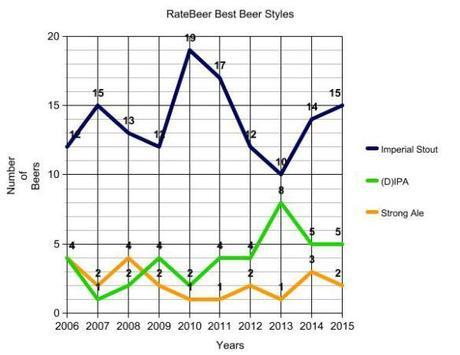
Of note, I've combined all IPAs and double IPAs because only one "regular" IPA has appeared in the top 25, AleSmith YuleSmith India Pale Ale was 11th in the 2006 list. 2013's number also includes Three Floyds Zombie Dust because even though it's technically listed as a pale ale, it's a 6.4 percent and hopped to high heaven with Citra.
If you're curious, here's the full breakdown of styles from the past 10 years.
Why so many imperial stouts on 2010's list? Here was my guess from my previous research on RateBeer rankings:
In 2010, All About Beer magazine noted that the "resurrection of languishing stylistic gems might be America's greatest contribution to brewing in the past 30 years. This would most certainly be the case with Russian imperial stout."
For what it's worth, Google Trends shows an initial spike in searches for "imperial stout" at the start of 2009, showing that awareness - or at least curiosity - started to pick up in the 2009/2010 timeframe.
If anything, looking at the average ABV among top-25 beers only emphasizes RateBeer users' love of boozy brews.
First, here's the average ABV among all top 25 beers from the past 10 years of lists:
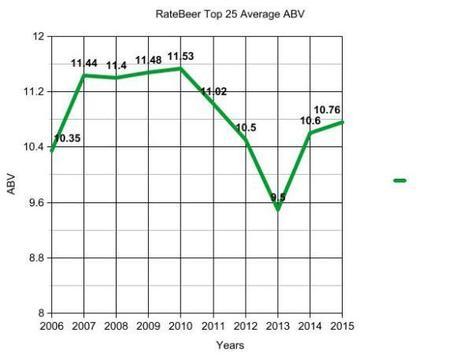
What's wrong with 2013? The average dipped below 10 percent because the list contained (gasp!) four beers under 8 percent:
- Cantillon Fou' Foune
- 3 Fonteinen Framboos
- Three Floyds Zombie Dust
- Hill Farmstead Society & Solitude #5
Aside from that, there may be a reason for the small drop-off from early years, but more on that in a moment.
If the top 25 beers offer a glimpse into the "best of the best," then let's narrow it even more. Here's a chart marking the average ABV of the top 5 and top 10 beers from each list:
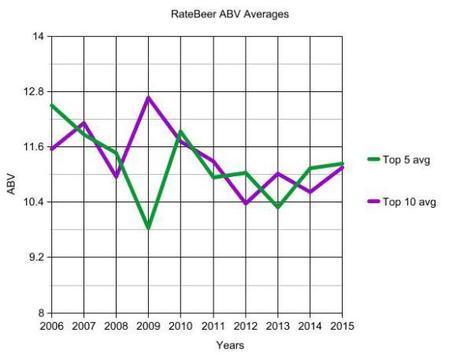
2009 was another odd year in terms of RateBeer's consistency, seeing two wild ales crack the top 5 at 7.5 percent (Lost Abbey Yellow Bus) and 7 percent (Struise Dirty Horse). The back end of the top 10 is bolstered by 29 percent behemoth Hair of the Dog Dave.
Lastly, here is all three averages put together:
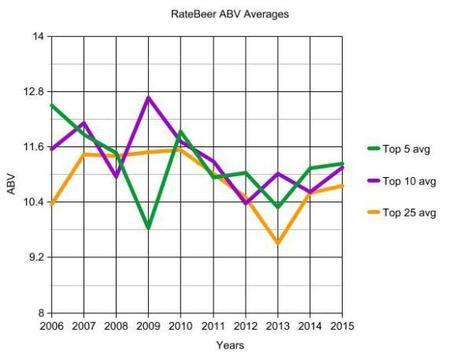
All in all, it's pretty consistent. Even though I found a national average from Beer Advocate to be 8 percent ABV, RateBeer sits pretty comfortably between 10 and 11 percent.
The previous two analyses certainly showed something, whether that was a changing of the guard of "best beer" or hinting at the "boring" beers that may now be classics in our ever-growing beer culture.
But my biggest takeaway from looking at today's data points to 2013's list, which represents beer ratings in 2012. To me, this further helps pinpoint a shift in the beer drinker culture, as that list had the highest variety of styles (eight) as well as the biggest tally of IPAs, which we know are a big deal for beer lovers.
However, even though the number of styles represented decrease to five in 2014 and 2015's lists, what we've started to see is a (very) slow shift toward different beers cracking the top 25.
If you look at all the top 25 beers from the past 10 years, one thing clearly stands out: the system used by RateBeer favors consistency. Unlike Beer Advocate's proprietary system that shows fluctuation among best beers - even if they stay among the best - RateBeer's year-to-year lists often include many of the same beers. Going back to the early versions of the list, the top 25 beers pretty much just reshuffle from one spot to another.
Which may lend more credence to the thought of beer lovers losing interest in "classic" beers like North Coast Old Rasputin and Russian River Blind Pig IPA. If a big move happens on RateBeer's lists, it seems to be happening dramatically.
But I'm just one person ... what are your thoughts on all of this? Editor's note: RateBeer's lists are numbered for the year they are released (2015) but cover the prior year (2014). So future references will match. For example, 2014's list represents 2013, 2013 covers 2012 and so on. Related:+Bryan Roth
"Don't drink to get drunk. Drink to enjoy life." - Jack Kerouac

